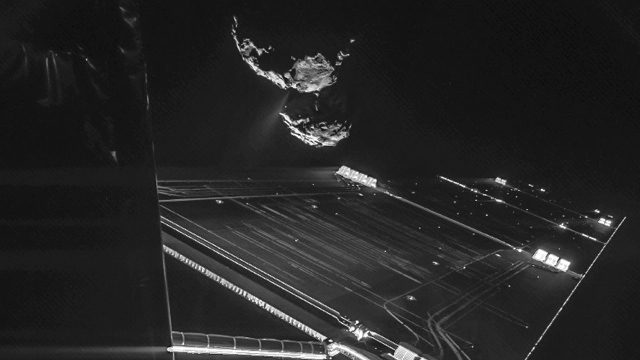SUMMARY
This is AI generated summarization, which may have errors. For context, always refer to the full article.

PARIS, France (UPDATED) – The European probe Philae was “working well” on the surface of its host comet, though likely perched on a steep slope, ground controllers said a day after the probe made its historic landing.
Some data suggested the washing machine-sized probe may have touched down three times on the low-gravity comet, which is zipping towards the Sun at 18 kilometers per second (11 miles per second), according to updates from ground control.
Philae’s anchoring harpoons failed to deploy, but it still managed to send back scientific data for the European Space Agency (ESA) flagship mission as well as the first-ever picture taken from the surface of a comet.
“Philae is working well. Its battery is working well and is providing power,” mission head Philippe Gaudon of France’s CNES space agency told AFP by phone from ground control in Toulouse on Thursday.
But photos the robot lab had sent suggested “it is likely on a steep slope”.
A tweet in the name of Philae’s MUPUS onboard instrument said: Magnetic analysis reveals 3 landings at 15:33, 17:26 & 17:33 UTC (GMT).”
“Short status update: we believe that Philae bounced (possibly 3 times) but sits safely on the comet now,” said another at 0800 GMT.
The ESA was to brief the press at 1300 GMT.
Equipped with 10 instruments, Philae is designed to carry out an array of experiments on Comet 67P/Churyumov-Gerasimenko.
It is the highlight of a massively complicated 1.3-billion-euro ($1.6-billion) project more than two decades in the making.
The mission aims to test theories that comets — primordial clusters of ice and dust — hold secrets about how the Solar System was constructed 4.6 billion years ago, and maybe also seeded Earth with some of the ingredients for life.
Rosetta, carrying Philae, was hoisted into space in 2004, and took more than a decade to reach its target in August this year, having used the gravitational pull of Earth and Mars as slingshots to build up speed.
The pair covered 6.5 billion kilometers (four billion miles) together before Wednesday’s separation and Philae’s 20-kilometre descent.
The first signal confirming touchdown was met with jubilation at ground control in Darmstadt, Germany.
But this was soon replaced by worry when fluctuations in the radio signal indicated the 100-kilogram (220-pound) lander may have lifted off again.
‘Good news’
Jean-Yves Le Gall, head of France’s CNES space agency, on Thursday reported “three pieces of good news” about Philae while a check-up was underway.
“Philae spent the night on the comet and we have three pieces of good news: the first is that Philae has landed on the comet,” he said on Europe 1 radio.
“Secondly, Philae is receiving energy, its solar panels are activated and this allows it to envisage a future. Thirdly, we are in permanent contact with Philae, via Rosetta.”
Philae was designed to touch down at a gentle 3.5 km per hour, then fire two harpoons into a surface engineers hoped would provide sufficient grip while the robot conducts its experiments.
The harpoons, though, failed to deploy.
Envisaged tests include drilling through the comet surface and analyzing the samples for chemical signatures.
Philae was designed to operate for about 60 hours on a stored battery charge, but several months more with a sunlight boost.
The lander complements 11 instruments aboard Rosetta, a three-ton orbiter responsible for four-fifths of the expected scientific haul from its vantage point in orbit.
Whatever happens to Philae, Rosetta will continue to escort the comet as it loops around the Sun. On August 13, 2015, “67P” will come within 186 million kilometers of the star.
The mission is scheduled to end in December 2015, when the comet heads out of the inner Solar System. – Rappler.com
Add a comment
How does this make you feel?
There are no comments yet. Add your comment to start the conversation.